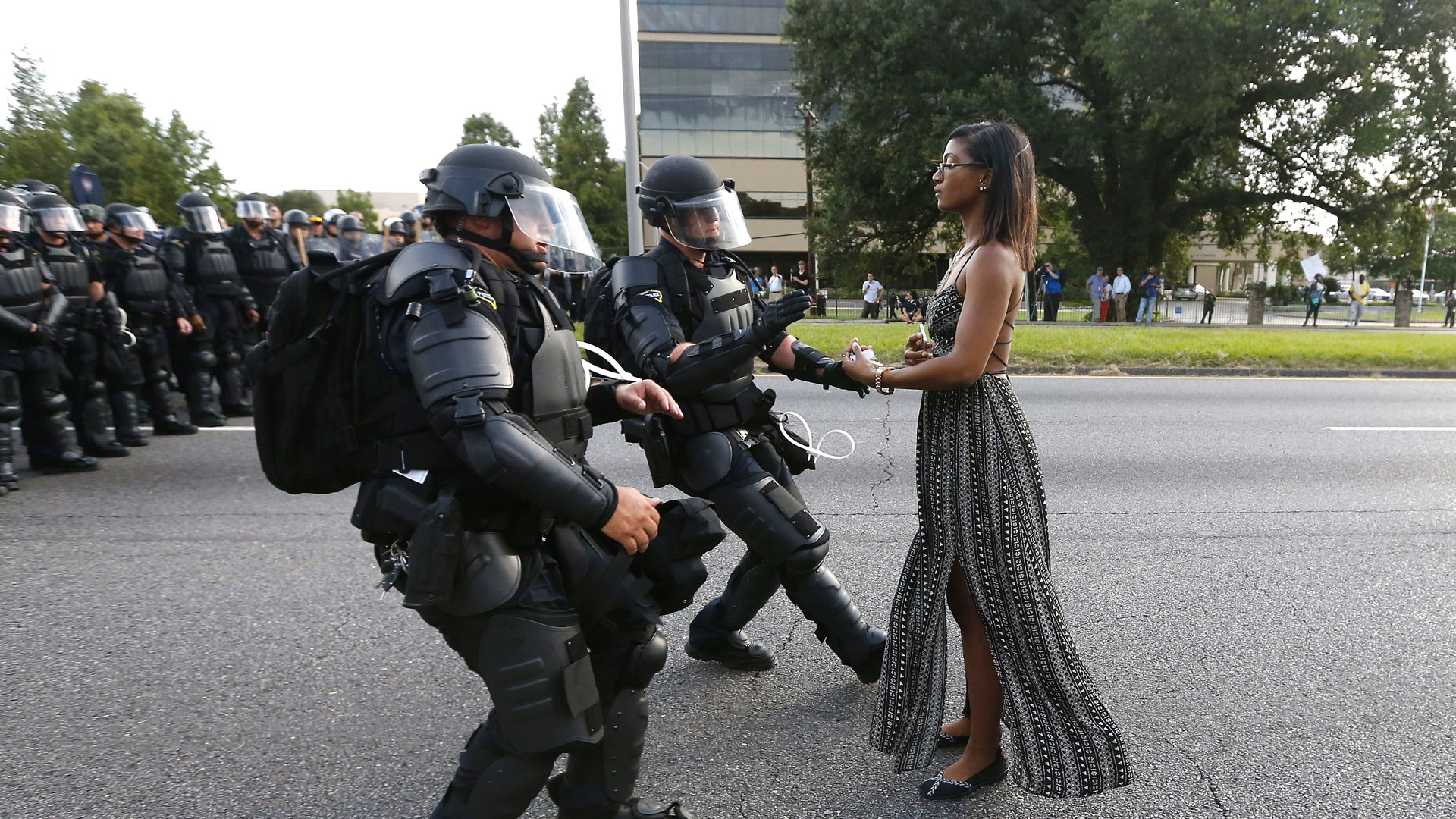January 23, 2023
When Peace Defeats War
Linda Stasi | Museum of Civil Rights

Jonathan Bachman—Reuters
As soon as the photograph of Ieshia Evans began to circulate online, people said she looked like a superhero. There she stands, slim and straight, on a street in Baton Rouge. Her dress, abstractly patterned in black and white, swirls around her. She seems almost to be levitating.
Opposite her are the cops, clad in black. They are only two, walking ahead of a phalanx of more than a dozen others. But because of the storm-trooper get-up — the shoulder pads, helmets and what look like rocket-booster backpacks — the two seem like three or four. Their legs advance while their upper bodies lean back, as though recoiling from an unseen force. She is unarmed and unafraid (the open space behind her emphasizes her singularity); they are militarized and unindividuated. The image told such an apparently clear story that when it hit social media, it went viral.
The relationship between superhero movies and the photographs from Black Lives Matter is not a matter of photographers trying to make protesters look like superheroes. It is that when such photographs emerge from the countless thousands taken at rallies and similar events, they are immediately recognized by a crowd already sensitized to their formal qualities. The most successful of these images have relatively simple compositions, featuring a single protagonist alone or contending with a number of adversaries. The images, which play into our collective desire for defiance, look like things we’ve seen before. They are conceptually neat, perhaps even Manichaean.
Black Lives Matter photographs also have a deeper genealogy. In their basic trope of the individual confronting terrible power, one of their most striking antecedents is “Tank Man,” from June 5, 1989, near Beijing’s Tiananmen Square. These images (there are at least four variants, in addition to video footage), of an unknown solitary protester standing in the way of advancing tanks, encapsulate the plight but also the greatness of an individual taking extreme personal risk. But unlike the photos of Evans and others from Black Lives Matter, there’s an air of gloom around Tank Man. Given what we know happened in Tiananmen Square, we presume he was doomed in some way. A closer emotional comparison to the pictures from Black Lives Matter might be found in certain images of the civil rights movement, like Fred Ward’s photograph of the activist Gloria Richardson pushing her way past a National Guardsman’s bayonet in Cambridge, Md., in 1963. But even there, the mood is of dignity intruded upon rather than of outright victory.
Black Lives Matter photographs also have a deeper genealogy. In their basic trope of the individual confronting terrible power, one of their most striking antecedents is “Tank Man,” from June 5, 1989, near Beijing’s Tiananmen Square.
Images trigger our memory of the history of images. Ieshia Evans, standing full-length, in profile, calm, carrying something, her robes billowing from an unseen gust, reiterates almost perfectly the form of a nymph that the early-20th-century scholar Aby Warburg described in his “Mnemosyne Atlas.” Warburg, undertaking a historical study of repeated forms, showed that figures matching this description were present in works by Ghirlandaio, Botticelli and Raphael, as well as in Roman bas-reliefs. The immediate legibility of images like those of Evans cannot be separated from the way their dynamism, evocative of ancient painting and sculpture, honors the black body.
Trailer for "Loudmouth" about Reverend Jackson
Images trigger our memory of the history of images. Ieshia Evans, standing full-length, in profile, calm, carrying something, her robes billowing from an unseen gust, reiterates almost perfectly the form of a nymph that the early-20th-century scholar Aby Warburg described in his “Mnemosyne Atlas.” Warburg, undertaking a historical study of repeated forms, showed that figures matching this description were present in works by Ghirlandaio, Botticelli and Raphael, as well as in Roman bas-reliefs. The immediate legibility of images like those of Evans cannot be separated from the way their dynamism, evocative of ancient painting and sculpture, honors the black body.
Contact
8970 N. Brown St.
New York, NY 11207
Phone: +01 123 453 6782
Email: josh@civilrightsfoundationnyc.org
Twitter: @mocr_nyc
© 2022 Museum of Civil Rights
